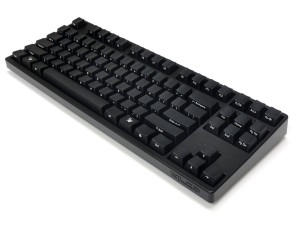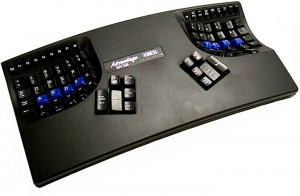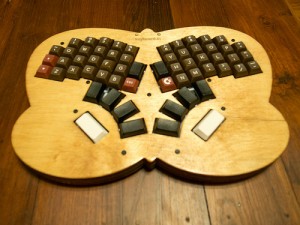You might want to read episode 1 first, in which I started documenting my quest to find an excellent keyboard that matches me.
 The keyboard I currently use at work is one I bought myself, a Filco Majestouch 2 TKL US layout, TKL meaning without the numeric keypad (so called Ten Key Less). In part one I said I was experiencing some strain in my left hand typically after a day of work or so.
The keyboard I currently use at work is one I bought myself, a Filco Majestouch 2 TKL US layout, TKL meaning without the numeric keypad (so called Ten Key Less). In part one I said I was experiencing some strain in my left hand typically after a day of work or so.
That doesn’t happen anymore.
To understand why, I’ll go back a few months from now. I was reading
Twitter, and I noticed a message from a friend.
He wasn’t using his Kinesis keyboard, and asked if anyone was interested. He was basically giving away his Kinesis.
(here’s an interesting article involving another Kinesis)
Surprise!
We got in touch and Tim shipped his keyboard to Norway. I had
been playing with the thought of buying one for a while, but it seemed
too expensive and I was not convinced at all that I could learn to type on it comfortably.
The very first time I plugged the keyboard in, I was at home (I mean I was literally at home), relaxed, very excited about learning how the Kinesis worked, where all the keys were located, and what was the hand-brain response. Everything went better than expected.
Next I brought the keyboard at work. That is when things started to
break down :-)
Kinesis at work
I’m slowly learning the Norwegian language. At work, where I spend most of the time, the “official” language is English. That means I don’t get a lot of practice for free, and it’s taking me a long time to become proficient.
When an opportunity to practice Norwegian comes up, I feel some resistance to use it because I suck at it. Add that English is more comfortable to use and everyone can understand it, and you have a good recipe to keep me from learning even longer :-)
Learning to type on a Kinesis is like speaking a new language. All the movements and keystrokes that are hardwired in your muscle memory suddenly cannot work anymore like you’re used to and you feel frustrated and helpless. I noticed I was at least 5-10 times slower than I was on my usual keyboard. This was the first week of usage.
Exercise!
The instruction manual for the Kinesis is something you definitely want to read and use. For many reasons. It explains how to activate many functions and special keys that otherwise you wouldn’t know how to.
More importantly, it warns you about this awkward reaction your body and fingers are going to have when you start using the keyboard and advices to perform some exercises to retrain your brain and muscle memory.
Those exercises are really effective, and after just a couple of days of doing them I saw a big difference in typing comfort and rate of errors. What I didn’t expect was to realize that they also help you type better no matter what keyboard you use. One of the key (ehm) lessons these exercises will teach you is when it’s better to use your left or right fingers.
For example, if I have to type # (the hash or square sign, on a US layout keyboard, upper symbol on the 3 key), I usually press the left SHIFT key with my pinky and then press 3 with my (left) middle finger.
The Kinesis manual strongly advices against that, and instead helps you learn to type # by depressing the right-side SHIFT instead with your right hand, and the 3 with your left hand. It will be much more comfortable and will result in much less strain after a long work session.
I guess here I just gave away that I’m no trained typist :-)
Oh well, that’s ok.
Back to black
Back to my (black) regular keyboard, I could really see that this way of typing helps in the long run, so I tried to practice it and now I find myself using these straining finger combinations a lot less.
But… what happened to the Kinesis then?
I learned to type decently on it, with an OK speed, still making more mistakes than I’d like, but at least not feeling frustrated. However, the Kinesis proved not to be the keyboard for me!
I truly believe it is an excellent keyboard. However, here’s my personal list of cons (beware, this is a nitpicky list):
- function keys and all other keys on that row, including escape, are too small and close to each other and lack the same mechanical switch feel of the rest of the keyboard.
- palm-rests are slightly too high, at least for me. I found them a bit uncomfortable.
- no Control key on the right (or was it left?) side, so sometimes using the correct key combination takes either two keystrokes or must be done with the same hand instead of using (properly) two.
keyboard.io
I’ve been following Jesse Vincent’s blog for a while now, enough to know he’s a keyboard enthusiast (nerd?) and has been building a lot of keyboard prototypes, to find “The One”, and he went on to found the keyboard.io initiative.
That’s interesting, because following his posts, I can see that I am looking at exactly the same features and ergonomicity(?) when evaluating a keyboard for daily — programming — use.
Here’s the keyboard.io “00” model:
It would be very interesting to try it. It’s not sold yet, so feedback can be limited to what I can see:- It’s clear that a lot of design and thought has gone into this keyboard, and it’s probably just right for Jesse that built it, so it can’t be any better from that point of view.
- The use of wood instead of a more keyboardy material feels strange, like those “Diamond iPhone” products, or crocodile skin shoes or something like that. Maybe it’s awesome, but that’s how it feels to me.
- Key placement seems to be the most compelling and studied feature of this keyboard. It seems to map actual hands and fingers closer than any other keyboard I’ve seen, including the ergonomic ones. It’s hard to imagine (without having one here with me at the moment :-) how to use the thumb, especially with the white key. That one seems to be right under the finger “body”. Not sure.
- The “butterfly” shape doesn’t feel like professional to me. I wouldn’t associate it with a model that a keyboard nerd would want to buy. From the pictures it seems like the vertical (longitudinal) dimension is very large compared to the width. I guess it’s not a keyboard that people want to carry around too much :-)
- I hope the cable is at least 1.5m in length. It’s never long enough.
That’s it for part 2.
I’m still sticking to the Filco for now! :-)

